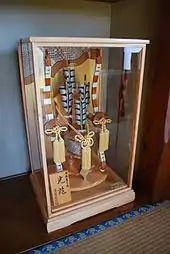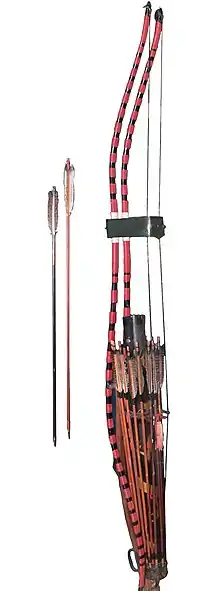Azusa Yumi
An azusa yumi (梓弓), is a sacred bow (yumi) used in certain Shinto rituals in Japan, as well as a Japanese musical bow, made from the wood of the Japanese azusa (梓) or Japanese cherry birch tree (Betula grossa). Playing an azusa yumi forms part of some Shinto rituals; in Japan, it is universally believed that merely the twanging of the bowstring will frighten ghosts and evil spirits away from a house. In Japanese poetry, the word azusa yumi functions as a makurakotoba ("pillow word", a kind of epithet).
 Japanese Yumi, with Ya | |
| Classification | String |
|---|---|
| Look up azusayumi in Wiktionary, the free dictionary. |

The story is told in Japanese mythology that a golden bird perched on the bow of Emperor Jimmu, the great-grandson of the sun goddess Amaterasu, and the first human ruler of Japan. This was seen as an extremely good omen; Jimmu's bow developed the power to dispel evil by the mere plucking of its string. His bow was made of azusa wood, specifically the Betula grossa or Japanese cherry birch.
Since that time, 59 azusa yumi (29 vermilion and 30 black - vermilion signifying male energy and black female energy) have been enshrined at the Ise Grand Shrine, Japan's most important Shinto shrine and the main residence of Amaterasu. They serve to protect and purify the shrine's sacred inner chamber. These bows that are enshrined at Ise become Goshimpo-yumi (Great Treasures of the Gods). Every twenty years the inner chamber of the Shrine is renewed and new offerings are made — including the Goshimpo-yumi.